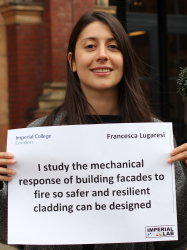Publications
3 results found
Lugaresi F, Sedlak B, Kotsovinos P, et al., 2023, Thermal response of a curtain wall framing system under fire conditions, FIRE SAFETY JOURNAL, Vol: 140, ISSN: 0379-7112
- Author Web Link
- Cite
- Citations: 1
Lugaresi F, Kotsovinos P, Lenk P, et al., 2022, Review of the mechanical failure of non-combustible facade systems in fire, CONSTRUCTION AND BUILDING MATERIALS, Vol: 361, ISSN: 0950-0618
- Author Web Link
- Cite
- Citations: 3
Kotsovinos P, Atalioti A, Rein G, et al., 2020, Analysis of the thermomechanical response of structural cables subject to fire, Fire Technology, Vol: 56, Pages: 515-543, ISSN: 0015-2684
Cable-supported structures such as bridges and stadia are critical for the surrounding community and the consequences arising from a major fire event can be substantial. Previous computational studies into the thermal response of cables often employed simplistic heat transfer models that assumed lump capacitance or cross-sectional homogeneity without proof of validity. This paper proposes a methodology for calculating the thermal response of a cable cross-section allowing for heat transfer by conduction through each strand contact surface and radiation across inter-strand cavities. The methodology has been validated against two experiments of cables subjected to radiant heating and an input sensitivity analysis has been undertaken for the heat transfer and material parameters. The approach is compared against simple heat transfer lumped methods for a parallel-strand cable where it is shown that these lumped models are not always conservative. The model is then coupled with a two-dimensional generalised plain strain model to study the likely effect of the cross-sectional temperature gradients on the mechanical response. The study considers three qualitatively different hydrocarbon jet fire scenarios, both with and without external insulation for fire protection. It is shown that the proposed methodology can reproduce realistic cross-sectional temperature distributions with up to 50% temperature difference at the cable external surface and can capture the phenomenon of load shedding in a gradually heated cable. It is also shown that assuming a lumped thermal mass neglects the possibility of moment-inducing temperature gradients which are not considered in the ambient design of cables that is driven by tensile capacities. The proposed model and its predictions contribute towards an improved understanding and a more informed structural design of cable-supported structures in fire.
This data is extracted from the Web of Science and reproduced under a licence from Thomson Reuters. You may not copy or re-distribute this data in whole or in part without the written consent of the Science business of Thomson Reuters.

